|
|
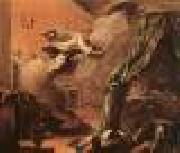 |
RICCI, Sebastiano
|
|
Italian painter, Venetian school (b. 1659, Belluno, d. 1734, Venezia).Painter and draughtsman. He painted light and colourful religious, historical and mythological subjects with a fluid, painterly touch. His rediscovery of Paolo Veronese, whose settings and costumes he borrowed, was important to later Venetian painters. Sebastiano was an itinerant artist, celebrated throughout Europe. |
|
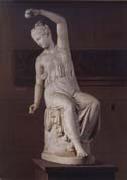 |
Ridolfo Schadow
|
|
1786-1822 Rome,Sculptor, son of Johann Gottfried Schadow. He trained in his father's studio in Berlin, exhibiting statues and reliefs at the Berlin Akademie exhibitions between 1802 and 1810. Work from this period included both mythological and religious subjects, such as the plaster relief The Flood (c. 1804; Berlin, Alte N.G.). In 1810, with his brother Wilhelm Schadow, Ridolfo moved to Rome, in 1811 taking over the Roman sculpture studio of Christian Daniel Rauch. Schadow's first Roman work, a statue of Paris (destr.; several copies, e.g. bronze, 1820; Potsdam, Schloss Charlottenhof) was exhibited at the Berlin Akademie in 1812, and it reveals the influence of the Danish sculptor Bertel Thorvaldsen. Although homesickness and lack of confidence drove Schadow briefly back to Berlin, he soon returned to Rome, along with Rauch. From this point Schadow's work is markedly individual: he brought a realistic, genre treatment to his figures, which drew on both classical tradition and the formal language of idealizing early 19th-century painting. He chose subjects that offered scope for idealization within a realistic context, as in the seated figures of a Woman Fastening her Sandals (marble, 1813; Munich, Bayer. Nmus.), a Woman Spinning (marble, 1816; Cologne, Wallraf-Richartz-Mus.) and a Girl with Doves (Innocence) (marble, 1820; Berlin, Alte N.G.). Under the influence of his brother Wilhelm and of Friedrich Overbeck, Schadow converted to Catholicism in 1814. His early death interrupted work on the plaster model for a sculptural group, |
|
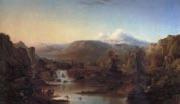 |
Robert S.Duncanson
|
|
American artist .
1821-1872
A self-taught mulatto artist and a landscape painter of the Hudson River school tradition, Duncanson was the first Afro-American artist to receive international recognition. Born into a family of painters and handymen, Duncanson first worked as a house-painter and glazier in Monroe, MI. By 1841 he was in Cincinnati, OH, where he learnt to paint by executing portraits and copying prints. Throughout the 1840s he travelled as an itinerant artist between Cincinnati, Monroe and Detroit. |
|
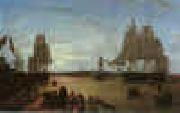 |
Robert Salmon
|
|
1775-1844
American painter of English origin. Having trained and painted in England and Scotland, he moved to Boston in 1828, painting in a 'little hut' near the wharves of South Boston. Reportedly an eccentric, he became a successful painter of marine views, adopting a range of different scales, including small wooden panels, larger canvases and theatre backdrops. Moonlight Coastal Scene (1836; St Louis, MO, A. Mus.) is typical of his works on panel, and it demonstrates his use of light to silhouette form. There are no extant examples of the panoramic views done as backdrops; his canvases such as Wharves of Boston (1829; Boston, MA, Old State House) and View of Charlestown (1833; Annapolis, MD, US Naval Acad. Mus.) are full of carefully delineated figures, minute and accurate details of the ships and their rigging, and, most importantly, large expanses of sky dominated by strong light. Salmon's portrayal of light-filled water and sky, increasingly luminous in the late 1830s and early 1840s, has caused him to be considered by some as the father of LUMINISM (i). He used a low viewpoint and contrasted a distant shoreline and small-scale figures in the foreground in a manner that prefigured the work of Fitz Hugh Lane and Martin Johnson Heade, both of whom were influenced by Salmon's manipulation of scale, light and subject-matter. It appears that he returned to England before his death. |
|
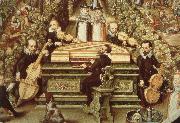 |
robert schumann
|
|
Date of birth: June 8, 1810 at Zwickau, Germany
Died: Jul 29, 1856 in Endenich, Germany Death: July 29, 1856 at Endenich, Germany |
|
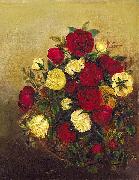 |
Robert Scott Duncanson
|
|
(1821 - December 21, 1872) was born in Seneca County, New York in 1821.Duncansones father was a Canadian of Scottish descent and his mother was an African American, thus making him ea freeborn person of color.e Duncanson, an artist who is relatively unknown today, painted America, both physically and figuratively, at a time when the country was in turmoil. Beautiful and serene, Duncansones work sheds light on American art that has been forgotten over the years.
|
|
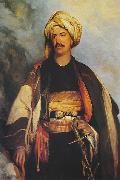 |
Robert Scott Lauder
|
|
Robert Scott Lauder (25 June 1803 - 21 April 1869) was a Scottish mid-Victorian artist who described himself as a "historical painter". He was one of the original members of the Royal Scottish Academy.
Lauder was born at Silvermills, Edinburgh, on 25 June 1803, the third son of John Lauder of Silvermills (died 1838), Burgess of Edinburgh and proprietor of the tannery at Silvermills, by his wife Helen Tait (d.1850). After attending the Royal High School he went to London, where his eldest brother William was engaged in the family business.
He returned to Edinburgh about 1826 and was elected one of the original members of the Royal Scottish Academy in 1830. On 9 September 1833 at St.Cuthberts in Edinburgh he married Isabella Ramsay Thomson and they then went abroad, accompanied by his younger artist-brother, James Eckford Lauder. Robert studied for some years in Rome, Florence, Bologna, Venice and Munich.
Lauder returned to London in 1838 where he lived for several years, where his three children - Isabella, John, and Robert, were baptised at St.Thomases Church, Southwark, in 1840, 1841, and 1844. Whilst in London he exhibited at the Royal Academy and competed in the Westminster Hall competition of 1847, sending his Christ walking on the Sea, which was subsequently purchased by Lady Angela Burdett-Coutts, 1st Baroness Burdett-Coutts. He became the first president of the short-lived National Institution of Fine Arts and also exhibited there.
He later removed back to Edinburgh in 1849 where both his sons - Robert Scott Lauder (born 1844), who became a physician, and John Thomson Lauder (1841-1865) - attended the Edinburgh Academy. Sir Walter Scott's novels provided him with subjects for many of his most successful historical paintings. About 1860 he suffered a paralytic stroke and did not practice after 1861. He died at Edinburgh from a bout of bronchitis on 21 April 1869, still paralysed. He is buried in Warriston Cemetery in Edinburgh. |
|
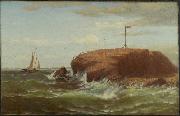 |
Robert Swain Gifford
|
|
(December 23, 1840 - January 13, 1905) was an American landscape painter. He was influenced by the Barbizon school.
Much of his work focuses on the landscapes of New England, where he was born. He, along with Victorian contemporaries from the White Mountain and Hudson River Schools, helped immortalize the majestic cliffs of Grand Manan in the Bay of Fundy. His painting from the island, "Pettes Cove," is illustrative of his masterful marine work.
In the 1870s, he undertook several journeys to Europe and the Middle East and painted some subjects from those regions. In 1899, he was an artist on the famous Harriman Alaska Expedition.
Some of his works hang in the most prominent galleries in the USA, including the Fine Arts Museums of San Francisco, the Metropolitan Museum of Art, New York, and the Smithsonian American Art Museum, Washington DC. He was a member of the Society of American Artists.
|
|
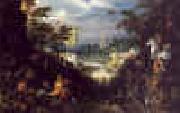 |
Roelandt Savery
|
|
1576-1639
Roelandt Savery Gallery
Like so many other artists, Savery's Anabaptist family fled North from the Spanish occupied Southern Netherlands when Roelant was about 4 years old and settled in Haarlem around 1585. He was taught painting by his older brother Jacob Savery (c.1565-1603) and Hans Bol.
After his schooling, Savery traveled to Prague around 1604, where he became court painter of the Emperors Rudolf II (1552-1612) and Mathias (1557-1619), who had made their court a center of mannerist art. Between 1606-1608 he traveled to Tyrol to study plants. Gillis d'Hondecoeter became his pupil.
Before 1616 Savery moved back to Amsterdam, and lived in the Sint Antoniesbreestraat. In 1618 he settled in Utrecht, where he joined the artist's guild a year later. His nephew Hans would become his most important assistant.
In 1621 Savery bought a large house on the Boterstraat in Utrecht. The house had a large garden with flowers and plants, where a number of fellow painters, like Adam Willaerts were frequent visitors. Savery had kept his house in Amsterdam, and had one child baptized in Nieuwe Kerk (Amsterdam).
Savery was friends with still life painters like Balthasar van der Ast and Ambrosius Bosschaert. In the 1620s he was one of the most successful painters in Utrecht, but later his life got troubled, perhaps because of heavy drinking. Though he would have pupils until the late 1630s, amongst which Allaert van Everdingen and Roelant Roghman, he went bankrupt in 1638 and died half a year later. |
|
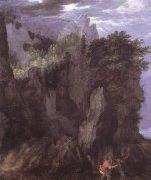 |
Roelant Savery
|
|
Flemish Northern Renaissance Painter, 1576-1639 . was a Flanders-born Dutch baroque painter of the Golden Age. Like so many other artists, Savery's Anabaptist family fled North from the Spanish occupied Southern Netherlands when Roelant was about 4 years old and settled in Haarlem around 1585. He was taught painting by his older brother Jacob Savery (c.1565-1603) and Hans Bol. After his schooling, Savery traveled to Prague around 1604, where he became court painter of the Emperors Rudolf II (1552-1612) and Mathias (1557-1619), who had made their court a center of mannerist art. Between 1606-1608 he traveled to Tyrol to study plants. Gillis d'Hondecoeter became his pupil.[3] Before 1616 Savery moved back to Amsterdam, and lived in the Sint Antoniesbreestraat. In 1618 he settled in Utrecht, where he joined the artist's guild a year later. His nephew Hans would become his most important assistant. In 1621 Savery bought a large house on the Boterstraat in Utrecht. The house had a large garden with flowers and plants, where a number of fellow painters, like Adam Willaerts were frequent visitors. Savery had kept his house in Amsterdam, and had one child baptized in Nieuwe Kerk (Amsterdam).[4] Savery was friends with still life painters like Balthasar van der Ast and Ambrosius Bosschaert. In the 1620s he was one of the most successful painters in Utrecht, but later his life got troubled, perhaps because of heavy drinking. Though he would have pupils until the late 1630s |
|
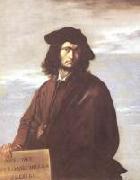 |
ROSA, Salvator
|
|
Italian Baroque Era Painter, 1615-1673
Italian painter, draughtsman, etcher, poet and actor. He was one of the most original artists and extravagant personalities of the 17th century. His most popular and influential works were his landscapes, the wild and mountainous beauty of which contrasted with the pastoral scenes of Claude Lorrain. Yet Rosa also painted macabre subjects, erudite philosophical allegories and grand historical themes; he was, moreover, the most significant satirical poet of the Italian 17th century, and there is a close relationship between his poetry and painting. His earliest biographers, Filippo Baldinucci and Giovanni Battista Passeri, both of whom knew him well, described at length his fiery temperament |
|
|
|
|
|
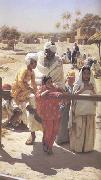 |
Rudolf Swoboda
|
|
1859 - 1914
was a 19th-century Austrian painter, born in Vienna. He studied under Leopold Carl M??ller, and voyaged with him to Egypt in 1880. He was a well-known Orientalist. In 1886, Queen Victoria commissioned Swoboda to paint several of a group of Indian artisans who had been brought to Windsor as part of the Golden Jubilee preparations. Victoria liked the resulting paintings so much that she paid Swoboda's way to India to paint more of her Indian subjects.Swoboda painted many of the ordinary people of India in a grouping of small (no more than eight inches high) paintings which resulted. While in India, he stayed, part of the time, with John Lockwood Kipling, and met his son Rudyard Kipling. The younger Kipling was unimpressed with Swoboda, writing to a friend about two "Austrian maniacs" who thought they were "almighty" artists aiming to "embrace the whole blazing East".Upon his return from India, he also painted (in 1888 and 1889) two portraits of Abdul Karim, |
|
|
|
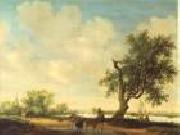 |
RUYSDAEL, Salomon van
|
|
Dutch Baroque Era Painter, ca.1600-1670.
Dutch painter. He is best known for his atmospheric, almost monochromatic, river scenes, painted in the 1630s during the 'tonal phase' of Dutch art. His work in this genre is very close in style to that of Jan van Goyen, and their paintings have often been confused. |
|
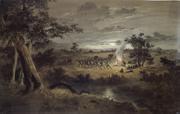 |
S.T.Gill
|
|
Australian original water-colour drawings and prints
b.1818-d.1880
also known by his signature S.T.G., was and English-born Australian artist. Gill was born in Perriton, Somerset, England, the eldest of five children. His father, the Reverend Samuel Gill, became headmaster of a school at Plymouth, and the son was educated first at this school and then at Dr Seabrook's Academy, Plymouth. Having moved to London, he was employed as a draughtsman and watercolour painter by the Hubard Profile Gallery, before departing for the colony of South Australia in 1839 with his parents. |
|
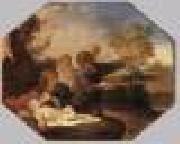 |
SACCHI, Andrea
|
|
Italian painter, Roman school (b. 1599, Nettuno, d. 1661, Roma).Italian painter and designer. He occupied an important position, midway between Annibale Carracci and Carlo Maratti, in the development of a more restrained, less decorative painting in 17th-century Rome, a trend that culminated in the 18th century with Pompeo Batoni. Sacchi trained with Francesco Albani, Carracci's student, and taught Maratti. His often expressed devotion to the art of Raphael and Carracci and his criticism of the views of Pietro da Cortona and Gianlorenzo Bernini made him, with Nicolas Poussin and Alessandro Algardi, one of the most significant representatives of a stylistic and aesthetic opposition to the more flamboyant, extrovert aspects of the High Baroque. Sacchi did not, however, share Poussin's passionate interest in Classical antiquity, nor was his mature work as cerebral. Yet his mature style, less richly coloured than his early manner and more restrained emotionally, |
|
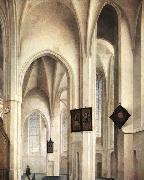 |
SAENREDAM, Pieter Jansz
|
|
Dutch Baroque Era Painter, 1597-1665,Painter and draughtsman, son of Jan Saenredam. His paintings of churches and the old town halls in Haarlem, Utrecht and Amsterdam must have been appreciated by contemporary viewers principally as faithful representations of familiar and meaningful monuments. Yet they also reveal his exceptional sensitivity to aesthetic values; his paintings embody the most discriminating considerations of composition, colouring and craftsmanship. His oeuvre is comparatively small, the paintings numbering no more than 60, and each is obviously the product of careful calculation and many weeks of work. Their most striking features, unusual in the genre, are their light, closely valued tonalities and their restrained, restful and delicately balanced compositions. These pictures, always executed on smooth panels, are remarkable for their sense of harmony and, in some instances, serenity. Here, perhaps, lies a trace of filial fidelity to the Mannerist tradition of refinement and elegance, of lines never lacking in precision and grace. But Mannerist figures and the more comparable components of strap- and scrollwork embellishment lack the tension and clarity of Saenredam's designs, which also have a completeness reminiscent of the fugues of Gerrit Sweelinck (1566-?1628).
|
|
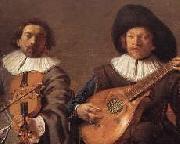 |
SAFTLEVEN, Cornelis
|
|
Dutch painter (b. 1607, Gorinchem, d. 1681, Rotterdam).Painter and draughtsman. After training as a painter in Rotterdam, he may have visited Antwerp c. 1632-4. From c. 1634 he was in Utrecht, where his brother (2) Herman the younger had settled, and they collaborated on a portrait of Godard van Reede and his Family (1634-5; Maarssen, Slot Zuylen). In 1637 Cornelis was back in Rotterdam, where in 1648 he married Catharina van der Heyden (d Rotterdam, 1654). The year after her death, he married Elisabeth van der Avondt. He became dean of the Guild of St Luke in Rotterdam in 1667. |
|
|
|
|
|
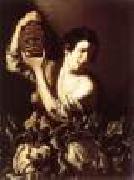 |
SALINI, Tommaso
|
|
Italian painter, Roman school (b. 1575, Roma, d. 1625, Roma).Italian painter. He has long been famed as a witness in the lawsuit of 1603 brought by his friend and biographer, Giovanni Baglione, against Caravaggio. His activity as a painter of religious works, still-lifes and genre paintings has been reconstructed in the decades following 1950, although his chronology remains uncertain. He entered the Accademia di S Luca in 1605 but was afterwards expelled on account of his 'difetto', to be readmitted in 1618. He was decorated with the Order of the Golden Spur and became a member of the Congregazione di Virtuosi al Pantheon. |
|
|
|
|
|
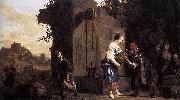 |
Salomon de Bray
|
|
(Amsterdam, 1597 - Haarlem, 11 May 1664) was a Dutch Golden Age architect and painter.
De Bray established himself in Haarlem before 1617, where he is registered as being a member of the schutterij that year in the St. Adrian's cloveniers.[1] He probably followed draftsmanship and painting lessons in the small academy started by Karel van Mander, Hendrick Goltzius and Cornelis van Haarlem, and where he married in 1625. He is registered as a pupil of Goltzius and Cornelis van Haarlem, but he probably started his training in Amsterdam with Jan Pynas, Nicolaes Moeyaert and Pieter Lastman.He painted history paintings, portraits and landscapes. As a Catholic he probably also made altar pieces for the Haarlem underground Catholic churches known as mission stations, or staties. He was a member of the Chamber of rhetoric called "De Wijngaertranken". This is probably how he met his wife Anna, the sister of the painter Jan and the poet Jacob Westerbaen. They married in 1625 and in 1630 he became a member of the Haarlem Guild of St. Luke. He cooperated with fellow Haarlem lukasguild member Jacob van Campen in the decoration of Huis ten Bosch in The Hague. His works draw on the spirit of the Dutch classicism beginning at that time, and are comparable with those of Pieter de Grebber.
Transcription of Salomon de Bray's proposed hierarchy of the guild in 1631. The Haarlem archivist C.J. Gonnet published a book in 1877 on the Haarlem St. Lukasgilde archives. This was meant for historians wishing to do research on Haarlem painting, but who could not read the old handwriting.De Bray was also active as a designer of silverwork, as a poet, as an architect and as a town planner for the city council of Haarlem. He designed an ambitious plan to expand the city on the North side that was partially implemented in the decades after his death. He became headman of the Guild of St. Luke and even prepared a new charter for the guild (that was never ratified) in 1631. As an architect, he was involved in the construction or expansion of Haarlem's City Hall, Zijlpoort, and St. Annakerk (Church of St. Anne), and Nijmegen's city orphanage. One of his poems was set to music by his friend the composer Cornelis Padbru??.
Salomon de Bray was the father of ten children, of whom three (Dirck de Bray, Jan de Bray, and Joseph de Bray) became notable artists. He probably died of the plague that hit Haarlem in 1664, as he and his children Jacob, Josef, Juliana and Margaretha all died in April and May of that year. His wife had already died the previous year. He was buried in the Sint-Bavokerk in Haarlem.
In 1631 Salomon de Bray wrote "Architectura Moderna" which provided a biography and descriptions of buildings built by Hendrick de Keyser, one of the key Dutch architects of the period
|
|
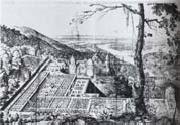 |
Salomon de Caus
|
|
b France, 1576; bur Paris, 28 Feb 1626,He was a Huguenot from the Dieppe region (Normandy). Between c. 1595 and 1598 he visited Italy, where he was strongly influenced by the gardens laid out c. 1570 by Bernardo Buontalenti at Pratolino, near Florence, and by their mechanical artifices. De Caus's work also reveals a knowledge of the gardens of the Villa d'Este in Tivoli. From c. 1598 to 1610 he was in Brussels, in the service of the Stadholder of the Netherlands, Albert, Archduke of Austria. There he was the engineer responsible for wells, fountains and the automatic works in the two grottoes (destr. 1768) in the garden of the Stadholder's residence. From 1610 he lived in England, moving in the artistic circle of Henry, Prince of Wales, to whom he taught drawing and for whom he built a picture gallery at Richmond. Together with Constantino de' Servi (1554-1622) he was engineer and supervisor of the waterworks at Richmond Palace. De Caus dedicated his first book, La Perspective (1612), to Prince Henry and included garden designs for the Prince in his second book, Les Raisons des forces movvantes (1615). He worked at several sites in England, including Somerset House in London, where he is thought to have erected a Parnassus, and at Greenwich Palace, Hatfield House and Gorhambury House (Herts) and Wilton House (Wilts). Nothing has survived of his work of this period. |
|
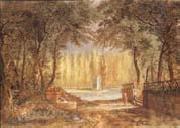 |
Salomon Gessner
|
|
Swiss Painter, 1730-1788,a bookseller's son, was apprenticed to the bookseller Spener in Berlin. Giving up this employment, he lived for a time by painting and engraving, for which he had a considerable talent. In 1750 he settled in Zurich, continuing to live by painting, including painting on porcelain. He began to write idylls in poetic prose, beginning with Daphnis (1754). His Idyllen (1756) achieved a nation-wide success. In Der Tod Abels (1758) he attempted an epic in prose, which was followed by two plays (Schaferspiele), two stories, including Der erste Schiffer, and a few more idylls, Neue Idyllen (1772). In his idylls, Geßner, who is indebted to Theocritus and Virgil, creates an idealized, orderly, almost horticultural state of nature, from which everything rough and craggy has been eliminated; his shepherds are similarly untouched by the ruder aspects of country life. His work embodies the city-dweller's longing for a nature which he does not know, and this explains its instant popularity. W. Raabe uses Gebner's Idyllen, the publication of which coincided with the outbreak of the Seven Years War |
|
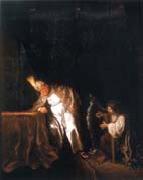 |
Salomon Koninck
|
|
Dutch Baroque Era Painter, 1609-1656,was a Dutch painter of genre scenes and portraits and engraver. Koninck was the son of a goldsmith, originally from Antwerp, and was a nephew of Philips de Koninck. Salomon became a pupil of Pieter Lastman, David Colijns, Francois Venants and Claes Corneliszoon Moeyaert. From 1630 he was a member of the Sint Lucasgilde. He moved in the circles of Rembrandt and the academy of Hendrick van Uylenburgh, making many copies of Rembrandt's compositions. His paintings have a warm colour palette and include "the philosopher". |
|
|
|
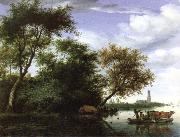 |
Salomon van Ruysdael
|
|
Salomon van Ruysdael (c. 1602, Naarden - buried Nov 3, 1670, Haarlem) was a Dutch landscape painter. He was the uncle of Jacob van Ruisdael. |
|
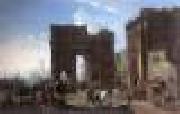 |
SALUCCI, Alessandro
|
|
Italian painter, Roman school (b. 1590, Firenze, d. 1655/60, Roma). Italian painter. He specialized in imaginary architectural perspectives and harbour views, in which the figures were executed by other artists, most notably Jan Miel and Michelangelo Cerquozzi. His pictures were praised by contemporary and near contemporary writers, including Carlo Malvasia, and during the 17th century were popular with private collectors in both Florence and Rome. However, many of the paintings mentioned in contemporary sources remain untraced. He is first documented in Rome in 1628, when, with Andrea Sacchi and Pietro da Cortona, he worked on the fresco decorations of the Villa Sacchetti (now Chigi), Castelfusano (nr Ostia), to which he contributed personifications of the River Nile and the River Rh?ne (in situ). He became a member of the Accademia di S Luca in Rome in 1634, and after 1635 he was engaged on frescoes (in situ) depicting sacred subjects in S Maria in Vallicella, Rome. From the mid-1630s onward Salucci collaborated with Miel on the imaginary architectural subjects for which he is best known, including the Perspective with Portico |
|
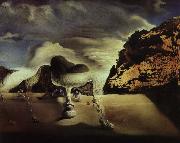 |
salvadore dali
|
|
Born: 11 May 1904
Birthplace: Figueres, Spain
Died: 23 January 1989 (Heart failure)
Best Known As: Surrealist artist with the curly mustache
|
|
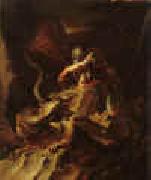 |
Salvator Rosa
|
|
1615-1673
Italian
Salvator Rosa Galleries
Salvatore Rosa (1615 - March 15, 1673) was an Italian Baroque painter, poet and printmaker, active in Naples, Rome and Florence. As a painter, he is best known as an "unorthodox and extravagant" and a "perpetual rebel" proto-Romantic. His life and writings were equally colorful.
He continued apprenticeship with Falcone, helping him complete his battlepiece canvases. In that studio, it is said that Lanfranco took notice of his work, and advised him to relocate to Rome, where he stayed from 1634-6.
Returning to Naples, he began painting haunting landscapes, overgrown with vegetation, or jagged beaches, mountains, and caves. Rosa was among the first to paint "romantic" landscapes, with a special turn for scenes of picturesque often turbulent and rugged scenes peopled with shepherds, brigands, seamen, soldiers. These early landscapes were sold cheaply through private dealers. This class of paintings peculiarly suited him.
He returned to Rome in 1638-39, where he was housed by Cardinal Francesco Maria Brancaccio, bishop of Viterbo. For the Chiesa Santa Maria della Morte in Viterbo, Rosa painted his first and one of his few altarpieces with an Incredulity of Thomas.
While Rosa had a facile genius at painting, he pursued a wide variety of arts: music, poetry, writing, etching, and acting. In Rome, he befriended Pietro Testa and Claude Lorraine. During a Roman carnival play he wrote and acted in a masque, in which his character bustled about Rome distributing satirical prescriptions for diseases of the body and more particularly of the mind. In costume, he inveighed against the farcical comedies acted in the Trastevere under the direction of Bernini.
While his plays were successful, this also gained him powerful enemies among patrons and artists, including Bernini himself, in Rome. By late 1639, he had had to relocate to Florence, where he stayed for 8 years. He had been in part, invited by a Cardinal Giancarlo de Medici. Once there, Rosa sponsored a combination of studio and salon of poets, playwrights, and painters --the so called Accademia dei Percossi ("Academy of the Stricken"). To the rigid art milieu of Florence, he introduced his canvases of wild landscapes; while influential, he gathered few true pupils. Another painter poet, Lorenzo Lippi, shared with Rosa the hospitality of the cardinal and the same circle of friends. Lippi encouraged him to proceed with the poem Il Malmantile Racquistato. He was well acquainted also with Ugo and Giulio Maffei, and housed with them in Volterra, where he wrote four satires Music, Poetry, Painting and War. About the same time he painted his own portrait, now in the National Gallery, London. |
|
|
|
|
|
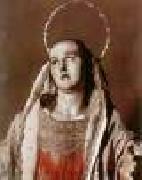 |
SALZILLO, Francisco
|
|
Spanish sculptor (b. 1707, Murcia, d. 1783, Murcia).
Spanish sculptor of Italian descent. He was trained by his father, Nicol Salzillo (1672-1727), a Neapolitan sculptor who had settled in Murcia, whose first documented work is dated 1700. Francisco also studied with the Jesuits and was taught drawing and sculpture by the cleric and painter Manuel Senchez ( fl 1731-9). He entered the Dominican Order in Murcia as a novice but left to take charge of his father's studio at the latter's death in 1727. Francisco was assisted by his brothers, Juan Antonio Salzillo and Patricio Salzillo, a priest, and by his sister, Ines Salzillo, who specialized in painting carved religious statues. In 1746 Francisco married Juana Vallejo Martenez, and in 1755 he was appointed escultor y modelista by the municipal government (ayuntamiento) and Inspector to the Inquisition for painting and sculpture in Murcia. In 1763 he established an academy |
|
|
|
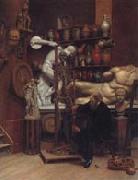 |
Samuel Butler
|
|
British author , (1835 - 1902)
Samuel Butler was born on Dec. 4, 1835, in Langar, near Bingham, Nottinghamshire, the son of the local vicar. In a time of common paternal absolutism, his childhood seems to have been bleak and graceless. After taking a degree at Cambridge, he came into open conflict with his father over the question of his future profession, and at last he emigrated to New Zealand to become a sheep farmer. But though free of his father, he was not free of revolt, and the spirit of resentful rebelliousness marked much of his later life. In New Zealand he read Charles Darwin's Origin of Species and wrote a series of newspaper articles setting forth Darwin's ideas and ingeniously applying the evolutionary hypothesis to machines. Having made a modest fortune, he returned to England in 1864. Erewhon (1872), Butler's first book, is a mixture of satire, utopian theories, and serious speculation masked as whimsy. Set in the frame of a trip to an unknown land (Erewhon is an anagram of "no-where"), it has no real plot but is rather a description and discussion of the customs and institutions of Erewhon. In this land moral failings are treated as mental illness and cured by a "straightener," but physical illness and misfortune are considered crimes and severely punished. Children sign certificates absolving their parents of responsibility for their birth, and education is carried on in the College of Unreason. Butler's reflections on orthodox religion, begun in New Zealand, issued in The Fair Haven (1873), an ironic attempt to reconcile the New Testament with rationalistic criticism. In Life and Habit he returned to the question of evolution. In Evolution Old and New (1879), Unconscious Memory (1880), and Luck, or Cunning? (1887), he developed his ideas with an increasingly self-righteous resentment of what he conceived to be the Darwinians' deliberate concealment of the truth. Butler hoped to be able to restore will, intelligence, and design to a universe apparently made meaningless by the blind process of natural selection. The novel The Way of All Flesh, Butler's most famous work, was written between 1872 and 1885. It is the supposed biography of Ernest Pontifex, narrated by an older friend with an unrelenting candor deliberately affronting conventional pieties. |
|
|
|
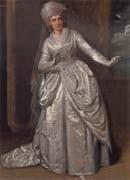 |
Samuel De Wilde
|
|
British 1748-1832,English painter and etcher of Dutch descent. He was the son of a Dutch joiner who had settled in London by 1748. On 19 November 1765 he was apprenticed for seven years to his godfather, Samuel Haworth, a joiner in London. However, he left after five years and enrolled as a student at the Royal Academy Schools in 1769. He exhibited small portraits at the Society of Artists (1776-8) and at the Royal Academy (from 1778), where he also showed fancy pictures of banditti in the style of Philippe Jacques de Loutherbourg. But the genre that he made very much his own was theatrical portraiture: he exhibited theatrical portraits at the Royal Academy almost every year from 1792 to 1821. |
|
|
|
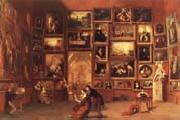 |
Samuel FB Morse
|
|
1791-1872,American painter and inventor. The son of a Calvinist minister, he began amateur sketching while a student at Yale College, New Haven, CT. After graduating in 1810, he returned to Charlestown, MA, to paint family portraits. In Boston in the same year he met Washington Allston, recently returned from Italy, under whose tutelage he executed his first history painting, the Landing of the Pilgrims at Plymouth (c. 1810-11; Boston, MA, Pub. Lib.). He joined Allston on his trip to London in 1811, enrolled in the Royal Academy Schools and also studied privately with Allston and Benjamin West. Morse Dying Hercules (1812-13; New Haven, CT, Yale U. A.G.), based on the pose and musculature of the Laokoon (Rome, Vatican, Mus. Pio-Clementino) and the theory evident in Allston Dead Man Restored to Life by Touching the Bones of the Prophet Elisha (1811-14; Philadelphia, PA Acad. F.A.), was critically acclaimed when exhibited at the Royal Academy and is indicative of Morse academic interests. After two trips in 1813 and 1814 to Bristol, where he painted a number of portraits and small subject pieces, Morse ended his period in England with another mythological history painting, the Judgement of Jupiter (1814-15; New Haven, CT, Yale U. A.G.). |
|
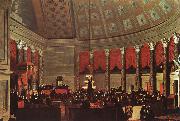 |
Samuel Finley Breese Morse
|
|
1791-1872
Samuel F.B. Morse was born on April 27, 1791 in Charlestown, Massachusetts, the first child of geographer and Pastor Jedidiah Morse (1761-1826) and Elizabeth Ann Breese (1766-1828). Jedidiah was a great preacher of the Calvinist faith and supporter of the American Federalist party. He not only saw it as a great preserver of Puritan traditions (strict observance of the Sabbath), but believed in its idea of an alliance with English in regards to a strong central government. Jedidiah strongly believed in education within a Federalist framework alongside the instillation of Calvinist virtues, morals and prayers for his son. After attending Phillips Academy in Andover, Massachusetts, Samuel Morse went on to Yale College to receive instruction in the subjects of religious philosophy, mathematics and science of horses. While at Yale, he attended lectures on electricity from Benjamin Silliman and Jeremiah Day. He earned money by painting. In 1810, he graduated from Yale.
Morse's Calvinist beliefs are evident in his painting the Landing of the Pilgrims, through the depiction of simplistic clothing as well as the austere facial features. This image captured the psychology of the Federalists; Calvinists from England brought to the United States ideas of religion and government thus forever linking the two countries. More importantly, this particular work attracted the attention of the famous artist, Washington Allston. Allston wanted Morse to accompany him to England to meet the artist Benjamin West. An agreement for a three- year stay was made with Jedidah, and young Morse set sail with Allston aboard the Lydia on July 15, 1811 (1).
Upon his arrival in England, Morse diligently worked at perfecting painting techniques under the watchful eye of Allston; by the end of 1811, he gained admittance to the Royal Academy. At the Academy, he fell in love with the Neo-classical art of the Renaissance and paid close attention to Michelangelo and Raphael. After observing and practicing life drawing and absorbing its anatomical demands, the young artist successfully produced his masterpiece, the Dying Hercules.
To some, the Dying Hercules seemed to represent a political statement against the British and also the American Federalists. The muscles apparently symbolized the strength of the young and vibrant United States versus the British and British-American supporters. During Morse??s time in Britain the Americans and English were engaged in the War of 1812 and division existed within United States society over loyalties. Anti-Federalists Americans aligned themselves with the French, abhorred the British, and believed a strong central government to be inherently dangerous to democracy.(3) As the war raged on, his letters to his parents became more anti-Federalist in their tones. In one such letter Morse said, "I assert that the Federalists in the Northern States have done more injury to their country by their violent opposition measures than a French alliance could. Their proceedings are copied into the English papers, read before Parliament, and circulated through their country, and what do they say of them... they call them (Federalists) cowards, a base set, say they are traitors to their country and ought to be hanged like traitors." |
|
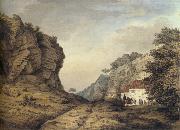 |
Samuel Hieronymous Grimm
|
|
Swiss Painter, 1733-1794
Swiss painter and draughtsman, active in England. He studied in Berne under Johann Ludwig Aberli and became established as a painter of topographical views in oil and watercolour. His early surviving works (e.g. River Landscape and Landscape with Chasseurs; Basle, priv. col.) are principally tinted drawings of landscapes and alpine scenery, with scenes of rustic life in the foreground; they display his characteristically charming and informal style. He also produced many decorative book illustrations: the frontispiece and plates to Friedrich von Hagedorn's Poetische Werke (1769-72) are among his finest. By 1764 Grimm had abandoned oils and was painting only in watercolour. From 1765 to 1768 he travelled and painted in France; he then moved to England, |
|
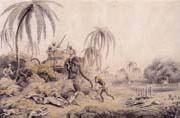 |
Samuel Howitt
|
|
English, 1756-1822,was an artist from England. Samuel Howitt was born into a wealthy Quaker family in Nottinghamshire, England. He began painting as a hobby and to amuse his friends. Hunting and racing were his hobbies and he mimicked this interest in his work. Howitt's family experienced financial difficulties, so Howitt decided to move to London. In London, Howitt made a career out of his talent, flourishing as a professional artist. He was published often in The Sporting Magazine and went on to illustrate various books. Howitt is best known for his lively and exotic sporting scenes. His superior watercolors and aquatints depict dramatic racing and hunting scenes as well as an array of conventional and exotic animals. Howitt's work is included in the Mellon Collection, which possesses no fewer than 160 of his watercolors, and many of his aquatints. Howitt exhibited at the Royal Academy and illustrated several books, including his own entitled The British Sportsman c.1812 and British Preserve c.1824. Samuel Howitt, "genius, artist, sportsman", concentrated his considerable artistic talents on picturing scenes of horse-racing and hunting in all its aspects. Born in Nottinghamshire, England, Howitt was largely self-taught ,"although he must have been helped by his companions George Morland, Rowlandson and John Raphael Smith. Howitt's watercolours of hunting, shooting and racing have delightful spontaneity. |
|
|
|
|
|
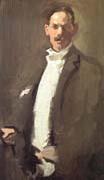 |
Samuel John Peploe
|
|
Scottish Painter, 1871-1935,Scottish painter. He studied at the Royal Scottish Academy schools from 1893 to 1894, and then at the Academie Julian and Acad?mie Colarossi in Paris, where he shared rooms with Robert Brough. The influence of the rustic realism of French painters and of the Glasgow Boys is clear in landscape drawings and paintings executed in Edinburgh from the mid-1890s. His still-life studies reveal the influence of the work of both Manet and Hals, which he saw in European galleries, with their combinations of thick impasto and fluid brushwork, dark background, strong lighting and meticulous handling of tones. Between 1900 and c. 1910, when he moved to Paris, he painted in Edinburgh, on sketching holidays in Scotland and in northern France with John Duncan Fergusson, and exhibited in Edinburgh, Glasgow and London. |
|
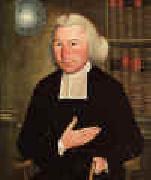 |
Samuel King
|
|
1748-1819
Samuel King Gallery
American painter, carver and nautical instrument maker. He was the son of Benjamin King, a mathematical and nautical instrument maker of Newport, RI. Samuel King's early portrait of the Rev. Ezra Stiles (New Haven, CT, Yale U. A.G.) is undoubtedly his masterpiece and a tour de force of symbolism. The portrait was begun in 1770 and completed on 1 August 1771. It shows the interest of the instrument maker in detail and exactitude of delineation. King's other known portraits show no such originality and in the main reflect compositions taken from portraits known to have been hanging in Newport at the time or from English prints. Since Samuel King and Charles Bird King (unrelated) were neighbours on Clarke Street in Newport, he probably influenced Charles Bird King. Washington Allston and Ann Hall (1792-1863) were both Samuel King's pupils. |
|
|

